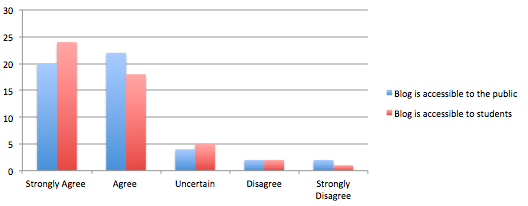
| Theme: 9II Virtual Patients/Social networking | |||
 |
||||||
| Academic Blogging: two goals, two results? |
 |
|||||
|
||||||
Weblogs or ‘blogs’ have existed for around two decades. There is no universally accepted definition of a blog, but most take the form of a discrete “posts”, each of which provide information and/or some analysis about a topic of interest to the blogger.
Academic blogs are a specific sub-type of weblog. They are equally hard to define. Halvais (2006) argues that most acadaemic blogs generate discussion, encourage ‘thinking-in-progress’ and have networked audiences who have little in the way of shared interests beyond those interests created by the blog. However, claiming that these are the defining characteristics of all academic blogs is unduly restrictive, especially since this excludes weblogs that are more pedagogical in nature.
For the last 18 months I have been writing an academic blog for The Conversation - an independent source of news and views, sourced from the academic and research community and delivered direct to the public.

The primary purpose of my blog is to critically analyse a range of issues in medical ethics in a manner that is easily accessible to the general public. For example, my November 2013 blog post discussed the suprisingly complex ethical, professional and legal dilemmas that can arise following a humble needlestick injury.

The secondary purpose of my blog is to generate a learning resource for healthcare students. In order to help fulfil this aim I try to write blogs that are linked to my lectures. For example, my September 2013 blog post was designed to fit with a lecture that I deliver on organ transplant ethics.

My research aims to explore whether my blog effectively achieves the dual aim of 'public engagement' and 'pedagogy'.
Between September 2013 and May 2014 I included a link to my blog in a standard PowerPoint slide at the end of my lectures. In June 2014 I distributed a paper questionnaire to 125 senior medical students who were attending various 'end of year' lectures. The students were given 10 minutes to complete the questionnaire at the end of the teaching sessions. The questionniare consisted of 3 open-ended questions and 10 closed-ended questions. The primary aim of the survey was to canvass the views of students about academic blogging in general and my blog in particular. A number of questions were designed to discover whether students thought that my blog was accessible to the general public and whether they thought that the blog was a useful learning resource for them.
100 students completed the questionnaire (a response rate of 80%). The majority of the responders (62%) were female and most (53%) were aged 26-35. 85% agreed or strongly agreed that academics should write blogs for the general public. 50% had read at least one of my blog posts. Of these, 48% read the blog 'frequently' and 40% read the blog 'occasionally'. The vast majority of the respondents who had read my blog thought that the blog was accessible to the general public and students (Figure 1.0). A majority of students (80%) also agreed or strongly agreed that the blog was a useful learning resource, but only a small minority (10%) thought that the blog was a useful revision aid.
Figure 1.0 - Accessibility of blog to the general public and students

Most of the students who had read the blog commented that they did so because they were interested in ethics. Some added that they read the blog because the blog posts were 'enjoyable' rather than because they were 'educational'. Of the students who had not read the blog almost all stated that they had not done so because they did not know about the blog or because they had not had time to look at it.
Academic blogging is increasingly recognised as an important academic activity. This is still a source of suprise and consternation for some. This is because bloggers were traditionally perceived as subversive and weblogs were regarded as unscholarly. However, many blogs are now formally hosted on university websites and some instiututions actively encourage academic blogging.
My blog is primairly aimed at the general public, but my blog posts are also written with students in mind. The results of my small survery suggest that my blog is both accessible to the general public and students and that some students use the blog as a learning resource. Further research is needed to explain students do not use the blogs as a revision aid. Much more research is also needed to discover how academic blogs are used by students and whether students regard them as an useful adjunct to formal learning.
- Academic blogging is increasingly mainstream
- My results suggest that a blog can be a useful resource for students and yet also be accessible to the general public
- The future of academic blogging is bright, but much more research is urgently needed in this area
Halavais, A. 2006. Scholarly blogging: moving towards the visible college. In Uses of blogs, ed. A. Burns and J. Jacobs, 117-26. New York: Peter Lang
Mewburn, I and Thomson, P. 2013. Why do academics blog? An analysis of audiences, purposes and challenges. Studies in Higher Education 38(8):1105-1119

 Send Email
Send Email